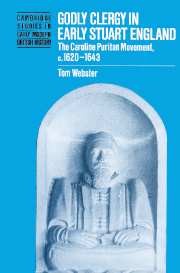Book contents
- Frontmatter
- Contents
- Acknowledgments
- List of abbreviations
- Introduction
- Part I Society, clerical conference and the Church of England
- Part II The godly ministry: piety and practice
- Part III ‘These uncomfortable times’: conformity and the godly ministers 1628–1638
- Part IV ‘These Dangerous Times’: the Puritan Diaspora 1631–1643
- Index
- Cambridge Studies in Early Modern History
Part II - The godly ministry: piety and practice
Published online by Cambridge University Press: 04 November 2009
- Frontmatter
- Contents
- Acknowledgments
- List of abbreviations
- Introduction
- Part I Society, clerical conference and the Church of England
- Part II The godly ministry: piety and practice
- Part III ‘These uncomfortable times’: conformity and the godly ministers 1628–1638
- Part IV ‘These Dangerous Times’: the Puritan Diaspora 1631–1643
- Index
- Cambridge Studies in Early Modern History
Summary
We have spent some time exploring clerical sociability among the godly clergy. However, we have had relatively little to say about what it meant to be a godly minister. We have encountered strong opinions among these clerical communities but rather neglected the holistic context from which these opinions drew their force. It is the purpose of this section to redress this balance. In what follows, I want to approach the godly ministry phenomenologically, as it were. That is to say, I want to attempt to enter into the experience of being a godly minister. One obvious way of doing this is to consider what the ministers wrote about their role. This approach is followed, but I want to do something more. It is necessary to go beyond printed pieties about the clerical ideal in order to gain insights into the meanings that shaped the world of the godly clergy. Thus I will begin by looking at the self-image of the ministers, giving some space to the preoccupations of their work and then go on to see how they structured experience, to examine the ways in which the subjectivity of godliness was constructed. There is space here for theology but, it will emerge, theology and doctrine are not sufficient in themselves to give a rounded view of clerical experience. The emphasis so far has been on a particular social dynamic and it would be both a step backwards and a missed opportunity to abandon this approach: the social context reveals a great deal about the religiosity and vice versa.
These approaches have a number of side effects. We have an opportunity to consider what, if anything, makes this piety distinctive.
- Type
- Chapter
- Information
- Godly Clergy in Early Stuart EnglandThe Caroline Puritan Movement, c.1620–1643, pp. 93 - 94Publisher: Cambridge University PressPrint publication year: 1997



